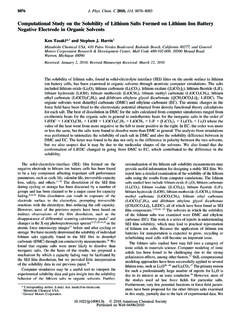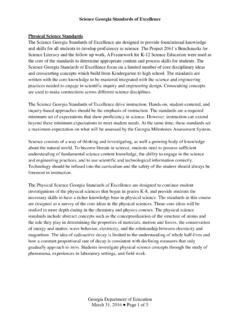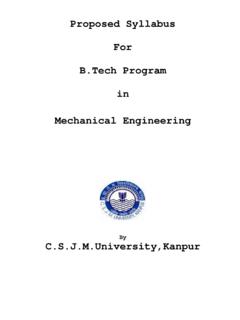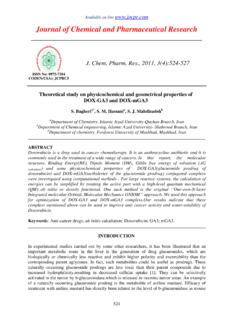Transcription of Current Status of Nanomedicine and REVIEW Medical ...
1 REVIEWC opyright 2005 American Scientific PublishersAll rights reservedPrinted in the United States of AmericaJournalofComputationalandTheoreti calNanoscienceVol .2, 1 25, 2005 Current Status of Nanomedicine andMedical , ,PaloAlto,California,USAN anomedicine is the process of diagnosing, treating, and preventing disease and traumatic injury, ofrelieving pain, and of preserving and improving human health, using molecular tools and molecularknowledge of the human body. In the relatively near term, Nanomedicine can address many impor-tant Medical problems by using nanoscale-structured materials and simple nanodevices that can bemanufactured today, including the interaction of nanostructured materials with biological the mid-term, biotechnology will make possible even more remarkable advances in molecularmedicine and biobotics, including microbiological biorobots or engineered organisms. In the longerterm, perhaps 10 20 years from today, the earliest molecular machine systems and nanorobotsmay join the Medical armamentarium, finally giving physicians the most potent tools imaginable toconquer human disease, ill-health, and :Assembly, Nanomaterials, Nanorobot, Nanorobotics.
2 Nanotechnology and Nanomedicine ..12 . Medical Nanomaterials and Nanodevices ..22 .1 . Nanopores .. Artificial Binding Sites andMolecular Imprinting ..32 .3 . Quantum Dots and Nanocrystals ..32 .4 . Fullerenes and Nanotubes ..42 .5 . Nanoshells and Magnetic Nanoprobes ..42 .6 . Targeted Nanoparticles and Smart Drugs ..52 .7 . Dendrimers and Dendrimer-Based Devices ..62 .8 . Radio-Controlled Biomolecules ..73 . Microscale Biological Robots ..84 . Medical Nanorobotics ..94 .1 . Early Thinking in Medical Nanorobotics ..94 .2 . Nanorobot Parts and Components ..94 .3 . Self-Assembly and Directed Parts Assembly .. 124 .4 . Positional Assembly and Molecular Manufacturing .. Medical Nanorobot Designs andScaling Studies .. 18 Acknowledgments .. 21 References .. 211 .NANOTECHNOLOGY ANDNANOMEDICINEA nnual federal funding for nanotechnology R&Dexceeded $500 million in 20021reaching $849 million inFY 20042and could approach $1 billion in next year sbudget.
3 The European Commission has set aside 1 .3 bil-lion euros for nanotechnology research during 2003 2006,3with annual nanotechnology investment worldwidereaching approximately $3 billion in 2003 .The world-wide market for nanoscale devices and molecular model-ing should grow 28%/year, rising from $406 million in2002 to $ billion in 2007, with a 35%/year growth ratein revenues from biomedical nanoscale December 2002 the National Institutes ofHealth announced a 4-year program for nanoscience andnanotechnology in interest in themedical applications of nanotechnology has led to theemergence of a new field called 5 12 Mostbroadly, Nanomedicine is the process of diagnosing, treat-ing, and preventing disease and traumatic injury, of reliev-ing pain, and of preserving and improving human health,using molecular tools and molecular knowledge of thehuman NIH Roadmap s new NanomedicineInitiatives, first released in late 2003.
4 Envision thatthis cutting-edge area of research will begin yieldingmedical benefits as early as 10 years from now andwill begin with establishing a handful of NanomedicineCenters staffed by a highly interdisciplinary scientificcrew including biologists, physicians, mathematicians, , , $ +.25 Status of Nanomedicine and Medical NanoroboticsFreitasengineers and computer scientists gathering extensiveinformation about how molecular machines are built whowill also develop a new kind of vocabulary lexicon to define biological parts and processes in engineeringterms .13 Even state-funded programs have begun, such asNew York s Alliance for Nanomedical the relatively near term, over the next 5 years, Nanomedicine can address many important Medical prob-lems by using nanoscale-structured materials and simplenanodevices that can be manufactured today (Section 2).
5 This includes the interaction of nanostructured materi-als with biological the next 5 10 years,biotechnology will make possible even more remark-able advances in molecular medicine and biobotics micro-biological robots or engineered organisms (Section 3) .Inthe longer term, perhaps 10 20 years from today, the ear-liest molecular machine systems and nanorobots may jointhe Medical armamentarium, finally giving physicians themost potent tools imaginable to conquer human disease,ill-health, and aging (Section 4).2 . Medical NANOMATERIALSAND NanoporesPerhaps one of the simplest Medical nanomaterials is a sur-face perforated with holes, or nanopores .In 1997 Desaiand Ferrari created what could be considered one of the ear-liest therapeutically useful nanomedical devices,15employ-ing bulk micromachining to fabricate tiny cell-containingchambers within single crystalline silicon wafers.
6 Thechambers interface with the surrounding biological envi-ronment through polycrystalline silicon filter membraneswhich are micromachined to present a high density of uni-form nanopores as small as 20 nanometers in pores are large enough to allow small moleculessuch as oxygen, glucose, and insulin to pass, but aresmall enough to impede the passage of much largerimmune system molecules such as immunoglobulins andRobert A. Freitas, Senior Research Fellow at the Institute for Molecular Manufactur-ing (IMM) in Palo Alto, California, and was a Research Scientist at Zyvex Corp .(Richard-son, Texas), the first molecular nanotechnology company, during 2000-2004 .He received B .S .degrees in Physics and Psychology from Harvey Mudd College in 1974 and a fromUniversity of Santa Clara in 1979 .Freitas co-edited the 1980 NASA feasibility analysis ofself-replicating space factories and in 1996 authored the first detailed technical design study ofa Medical nanorobot ever published in a peer-reviewed mainstream biomedical journal.
7 Morerecently, Freitas is the author of Nanomedicine , the first book-length technical discussion of thepotential Medical applications of molecular nanotechnology and Medical nanorobotics; the firsttwo volumes of this 4-volume series were published in 1999 and 2003 by Landes research interests include: Nanomedicine , Medical nanorobotics design, molecular machinesystems, diamond mechanosynthesis (theory and experimental pathways), molecular assemblersand nanofactories, and self-replication in machine and factory systems .He has published 25 ref-ereed journal publications and several contributed book chapters, and most recently co-authoredKinematic Self-Replicating Machines (2004), another first-of-its-kind technical virus particles .Safely ensconced behind thisartificial barrier, immunoisolated encapsulated rat pancre-atic cells may receive nutrients and remain healthy forweeks, secreting insulin back out through the pores whilethe immune system remains unaware of the foreign cellswhich it would normally attack and reject.
8 Microcap-sules containing replacement islets of Langerhans cells most likely easily-harvested piglet islet cells could beimplanted beneath the skin of some diabetes could temporarily restore the body s delicate glu-cose control feedback loop without the need for powerfulimmunosuppressants that can leave the patient at seriousrisk for infection .Supplying encapsulated new cells to thebody could also be a valuable way to treat other enzymeor hormone deficiency diseases,17including encapsulatedneurons which could be implanted in the brain and then beelectrically stimulated to release neurotransmitters, possi-bly as part of a future treatment for Alzheimer s or Parkin-son s flow of materials through nanopores can also beexternally first artificial voltage-gatedmolecular nanosieve was fabricated by Martin and collea-gues19in 1995 .Martin s membrane contains an arrayof cylindrical gold nanotubules with inside diameters assmall as nanometers.
9 When the tubules are positivelycharged, positive ions are excluded and only negative ionsare transported through the membrane .When the mem-brane receives a negative voltage, only positive ions canpass .Future similar nanodevices may combine voltage gat-ing with pore size, shape, and charge constraints to achieveprecise control of ion transport with significant molecu-lar specificity .Martin s recent efforts20have been directedat immobilizing biochemical molecular-recognition agentssuch as enzymes, antibodies, other proteins and DNAinside the nanotubes as active biological nanosensors,21to perform drug separations,22 23and to allow are investigating synthetic nanoporeion pumps,24voltage-gated nanopores embedded in artifi-cial membranes,25and an ion channel switch biosensor26that detects changes in chemical concentration of 10 ,1 25,2005 REVIEWF reitasCurrent Status of Nanomedicine and Medical NanoroboticsMolecular dynamics theoretical studies of viscosity27anddiffusion28through nanopores are in.
10 Daniel Branton s team at Harvard Universityhas conducted an ongoing series of experiments using anelectric field to drive a variety of RNA and DNA poly-mers through the central nanopore of an alpha-hemolysinprotein channel mounted in a lipid bilayer similar tothe outer membrane of a living 1998, Bran-ton had shown that the nanopore could be used torapidly discriminate between pyrimidine and purine seg-ments (the two types of nucleotide bases) along a sin-gle RNA molecule .In 2000, the scientists demonstratedthe ability to distinguish between DNA chains of simi-lar length and composition that differ only in base pairsequence . Current research is directed toward reliablyfabricating pores with specific diameters and repeatablegeometries at high precision,30understanding the unzip-ping of double-stranded DNA as one strand is pulledthrough the pore31and the recognition of folded DNAmolecules passing through the pore,32experiments withnew 3 10 nm silicon-nitride nanopores,32and investigatingthe benefits of adding electrically conducting electrodesto pores to improve longitudinal resolution possibly tothe single-base level for DNA.






